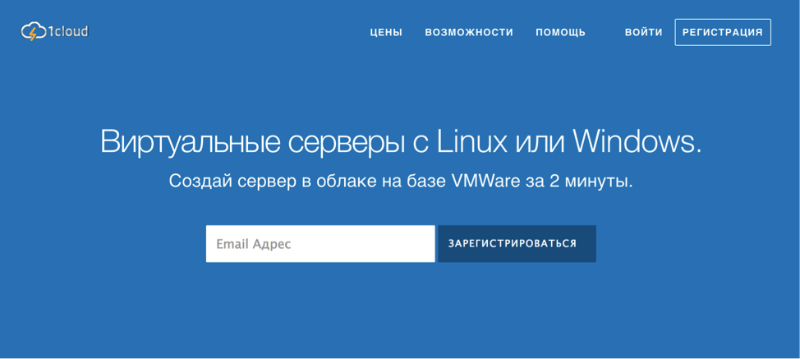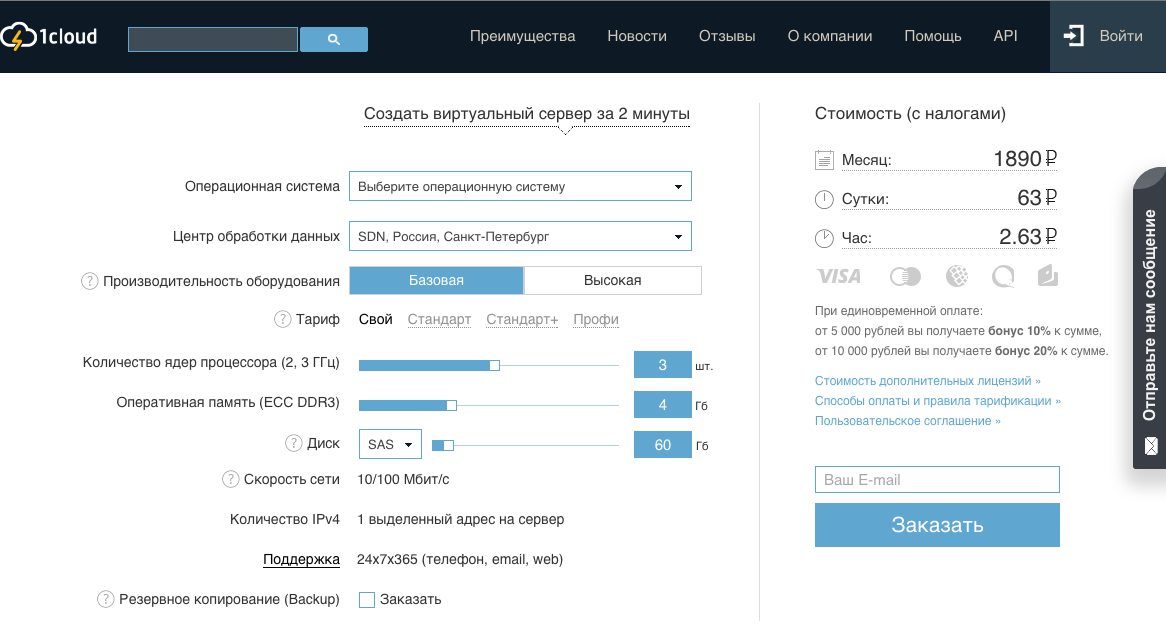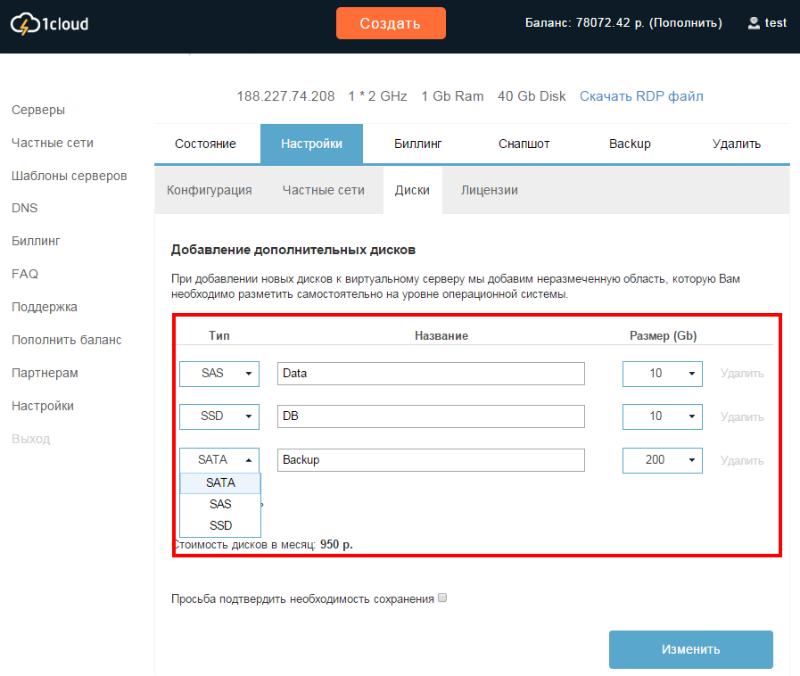How to create a virtual infrastructure provider: Experience 1cloud

This is a story about how the 1cloud service was created - how it was originally conceived and what it eventually became, what we learned about our users and what advice we can give to young IT companies. In this article we will focus on the issues of understanding the user audience and the design of interfaces: let's see how our customers see our work.
Initially, the founders of 1cloud, Vitaly Gritsay and Konstantin Kudryashov, conceived their project as a “cloud solutions store” - a service in which software producers and integrators would register their templates, and customers could deploy them at 1cloud capacities. As conceived by the founders, one of the most important advantages of this product was to be a user-friendly interface that would simplify the interaction between customers and software manufacturers.
')
However, after some time it became clear that the idea could not be realized in its original form: the analysis and the first tests showed that the direction of the project’s development should be changed. As a result, from the marketplace, 1cloud started moving towards the creation of an IaaS & PaaS provider with full automation of all customer requests.
This decision was not spontaneous: the entire team’s career, which was at the origin of the project, supported the IT infrastructures - as a result, a considerable amount of knowledge and experience was gained in managing them. For example, one of the founders of 1cloud, Vitaly Gritsay, before creating his own business, was head of the automation department at Peter-Service, which develops software for automating the activities of cellular operators (in particular, Megafon).
After making a decision on the transition from the marketplace to a virtual infrastructure provider, the project objectives have changed. The main task was to make complex things (from the point of view of IT infrastructure management) easy for users and lower the threshold for entry into this area among people who do not have specialized education. From the large-scale goals - to create a Russian supplier of IaaS & PaaS-solutions that can compete and surpass foreign counterparts (AWS, Microsoft Azure).
For whom we work: as we see the client
Determining the goals and objectives that the service should solve also helps with constant user research: for example, the initial ideas about the audience of potential consumers of our services for renting virtual infrastructure have changed quite a lot since the launch of the service. At first, we thought that the main mass of clients would be individuals - in reality, it turned out that companies become our users first of all.
In the course of our work, we have formed a more complete picture of who needs our services and why. The number of interested businesses ended up with:
1. Application developers. This category of users, it is important to quickly deploy test benches and production stands (as part of continuous integration processes).
2. Web-studios and site owners. For them, reliability becomes a plus with increasing load and the ability to flexibly change the configuration of virtual servers, thereby adapting it to current needs.
In addition, in the course of work, we found out that various web-based partner programs also turned out to be relevant for web studios: their occupation allows you to attract many clients for the cloud provider, which makes it possible to get a steady additional income (which they actively use).
3. Company integrators. It is especially important for such companies to save time when deploying servers for new clients - in particular, for them we have created the ability to customize our solutions and create a template from a migrated server.
4. Any business conducting accounting in 1s. Placing 1c accounting in the cloud makes it easy to organize distributed access to it: it is not necessary for accountants to be in the office to make any changes.
As for users - individuals, it is most interesting for them to use the virtual infrastructure for all sorts of tasks that require large computing powers, which are unlikely to exist on a home PC.
These are just a few examples of using virtual infrastructure for the needs of businesses and individuals - the number of such examples is growing both in the industry as a whole and in our practice - not least because of how we work on the user interface.
User Interface: how the customer sees us
Despite the change in the initial course, the goal is to make complicated things simple for users, to give them an understandable work tool, and it has not gone anywhere. Therefore, one of the first tasks that the team began to solve was the question of forming the appropriate service architecture and creating a user-friendly interface.
At the first stage, it was not without difficulties: the main problem in creating a service was the desire to “make a product for everyone at once” - the team tried to build an architecture that was too universal and suitable for any requirements. But for a young project, it is almost always redundant and leads to a slowdown in the development process and its excessive complexity.
The next difficulty on the way to creating a service was the choice of a suitable design. At first glance, the design is just a “wrapper”, something derivative in relation to the product itself. But we in 1cloud quickly came to understand that the interface and design is, in fact, the first, and often the only thing that the user faces, and it is impossible to ignore this sphere, considering it secondary.
At the stage of testing the business model, we decided to push off from the page design proposed by the Western IT company DigitalOcean: this solution, on the one hand, allowed us to quickly test the hypothesis and understand that our service would be useful to potential customers, on the other hand, caused a negative the side of those who did not like the visual similarity of our and Western products (all this was aggravated by the fact that we, a young company, did not have a full-time usability manager, so we had to maneuver between the offers of third-party contractors aznogo quality level).

Interface: then (hypothesis testing) ...

... and now (working product)
As a result, we were faced with the task of creating a service, the design of which will be not only convenient, but also unique. We tried to describe this process in detail in one of our materials : we approached the task systematically and decided to take into account not only our own (at that time still small) experience, but also other people's mistakes - in the end we managed to bypass a lot of pitfalls and not stuff our own cones.
The question of the support of a service with the relevant UX / UI solutions continues to accompany our work. So for example, when we started offering users different types of disks depending on the tasks set by the client, the natural continuation of this solution was the creation of an appropriate configurator:

For us, it is important not only the convenience of visual presentation and organization of information, but also the creation of conditions in which people with different technological backgrounds will be comfortable working with our system.
In particular, this need dictated our solution to implement virtual server templates in the system: this way users can easily create customized copies of virtual machines from scratch and spend a minimum of time scaling the system.

The desire to facilitate the work of users with the service extends not only to our direct responsibilities: for example, realizing that most of our customers are other companies, we decided to facilitate the process of generating bills and acts for legal entities.
It would seem that accounts, acts of accomplishment and acts of reconciliation are non-core activities for a virtual infrastructure provider, but the ability to see full information about the account and get copies of accounting documents for their needs directly from the browser is what makes life easier for our B2B clients no less than the ability to scale the system in a few clicks.
In the field of design and usability, our future plans are related to the creation of responsive website design and control panel. As part of the new design, the site will be completely redesigned: it will be more convenient than the previous one, it will be tuned to the ever-expanding capabilities of the service, and the new version of the site will be optimized in terms of searching for information that users pay attention to when they familiarize themselves with the 1cloud service.
In the near future, we plan to change the design of the web version of the service - to make it more attractive and understandable, to adapt to our ever-expanding capabilities and optimize the content of the site in terms of the most important information for users. In addition, in the future, launching a mobile application - we will definitely tell about the most interesting details of this process in our blog.
findings
Summing up, we would like to share with other projects tips that helped transform 1cloud from an idea into a developing service:
There is nothing wrong with making a pivot after a non-confirmation of this or that initial hypothesis. Our example is a living testimony.
The main source of your inspiration and solutions should be users. This is not just a banal truth: it is not necessary to mindlessly follow the desires of customers and implement everything exactly as one of them asks.
Try to look at the problem more broadly - you can not only provide the clients with the service that they really need, but also make all the steps accompanying this process as comfortable as possible: this happened when we decided to automate our accounting tasks for the convenience of legal entities.
Do not underestimate the importance of user interfaces: do not leave the solution to this problem "for later" and do not be afraid to replace the contractor, if you think that he can not cope with their duties.
Be careful about copying or borrowing other people's design solutions: on the one hand, they allow you to quickly assemble a working prototype and test a hypothesis, on the other hand, they can spoil the first impression of potential users.
It is possible that as a result, developers of a full-fledged version of the product will have a new task to distance themselves as much as possible from the original solution (albeit a good one, but too similar to someone else’s service).
If patterns and borrowing are a double-edged weapon, which one should use with great caution, then someone else's experience — both positive and negative — is something to which one should definitely look.
Do not be lazy to study other people's success stories (or failures) and do not step on the same rake: this “preparatory work” allowed us to get acquainted with the main mistakes in the design of IaaS interfaces in our industry and avoid them when creating our project.
Source: https://habr.com/ru/post/281889/
All Articles